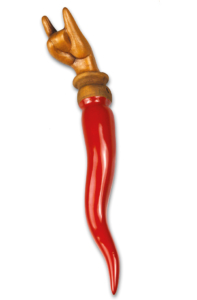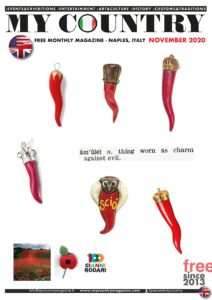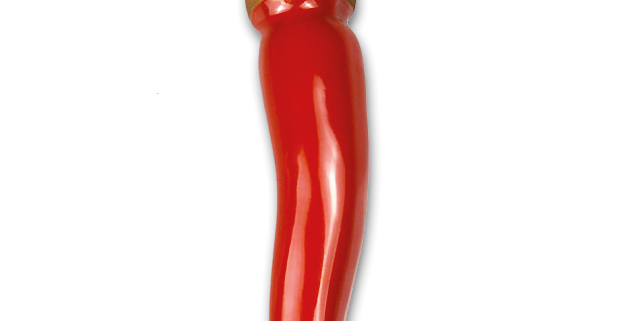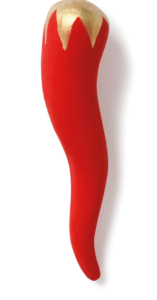The lucky horn O’curniciell amulet of Naples
MY LUCKY TRADITIONS
TRADITIONS SYMBOLS SUPERSTITIONS LUCK
The lucky horn
O’curniciell
amulet of Naples
“tuosto, stuorto e cu ‘a ponta”
Naples is a magical city full of miracles, mysteries and superstitions
– many of which have legends to tell from hundreds of years ago.
From Saints to throwing salt over your shoulder
– if you have been to Naples then you must have seen the red horn somewhere.
So, what’s it all about?
THE ORIGINS The red horn – commonly known as o’curniciell – corniciello or simply corno – resembles a hot pepper and is an important symbol and renowned amulet of Naples – regarding both tradition and superstition – with antique origins dating back to the Middle Ages when primitives associated the physical power of animals with the emblematic size of their horns… and to when populations of hunters hang bloody horns of large prey at the entrance of their homes to ward off enemies…
Well, there’s just a few of many explanations.
Various phallic symbols, very close in shape to the famous “curniciello” have also been discovered during various archaeological excavations of Pompeii and Ercolano (Herculaneum).
Although many lucky horn charms and trinkets were made of silver and terracotta, coral was and may be considered as the material believed to withhold powers strong enough to defeat any evil influences…
Many so-called lucky-charms have been present throughout history – including horseshoes, found not only in original iron forms but also made of terracotta and silver – dating from Roman times – and how about hanging scissors?
The “corno” form of artisanal talisman made fortune for craftsmen and jewellers dating back to the ancient Greeks – who used them to represent and protect fertility and commonly as power against evil.
The “Neapolitan horn” seems to have been an ally of the Neapolitan population for centuries – guarding against misfortune and negativity.
The local artisans of the “corno” were already present in Naples BC – from generations to today.
San Gregorio Armeno is commonly called Christmas Alley by tourists and hosts an array of craftsmen and colourful workshops
– renowned worldwide for the intricate nativity scenes and cribs known as “presepe”.
This popular zone is alive throughout the year – not only during the Christmas season and is known as the HEART OF NAPLES – Centro Storico – Decumani – frequently highlighted over the years by My Country magazine.

THE CHARACTERISTICS
The characteristics of O’curniciell:
‹ this “lucky charm” must be rigorously hand-made – to confer beneficial powers from the human touch
‹ the so-called “evil-eye” will be kept at bay only when the ornament is received as a gift
‹ the twisted talisman must represent a deep-red colour and unmistakeable shape
“tuosto, stuorto e cu ‘a ponta” – rigido, storto e con la punta – that’s literally: hard, crooked and pointed
‹ Please note: if the horn accidentally breaks – then don’t worry – it means that it has fulfilled its role to protect you!
So, BUONA FORTUNA! GOOD LUCK!
“Essere superstiziosi è da ignoranti, ma non esserlo porta male”
“Being superstitious is ignorant but not being so is bad luck”
– Eduardo De Filippo
© My Country magazine – Naples, Italy
NOVEMBER 2020 – pages 12-13






